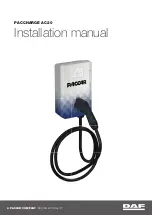
child seat that is not properly secured will not adequately protect a child in
a crash and may cause injury to the child or other vehicle occupants.
Never attach two child seats to the same anchor.
In a collision, one anchor may not be strong enough to hold two child seats
attachments and may break, causing serious injury or death.
Do not use the lower inner anchors of the outer rear seats to secure a
LATCH-compatible child seat to the rear center seat, unless the child seat
manufacturer's instructions for that system permit the use of inner
anchors with the stated spacing.
Installing a LATCH-compatible child seat in the rear center seat
Each outer rear seat is equipped with a pair of lower anchors which are
used to secure a LATCH-compatible child seat. The rear center seat,
however, is not equipped with anchors of any kind.
The inner and outer anchors are spaced apart at a standard distance of 11
inches (280 mm).
The distance between the two inner anchors is:
• 15.0 inches (380 mm)
LATCH-compatible restraint systems that are fitted with rigid-type
attachments cannot be installed in the rear center seat. However, a system
fitted with flexible-type attachments can be installed in the center seat,
provided that the manufacturer’s instructions for that system permit the use
of the inner anchors with the stated spacing.
Before seating a child, make sure that the system is properly attached to
both the lower anchors and tether anchors.
n
Installing a Child Seat with a Lap/Shoulder Seat Belt
A child seat can be installed with a lap/shoulder belt in any rear seat or, if
absolutely necessary, the front passenger seat.
SAFETY INFORMATION
22 |
1. Place the child seat on the vehicle
seat.
2. Route the seat belt through the child
seat according to the seat
manufacturer’s instructions, and
insert the latch plate into the buckle.
Insert the latch plate fully until it
clicks.
3. Slowly pull the shoulder part of the
belt all the way out until it stops.
This activates the lockable
retractor.
4. Let the seat belt retract a few
inches and check that the retractor
has switched modes by pulling on
the webbing. It should not pull out
again until it is reset by removing
the latch plate from the buckle. If
you are able to pull the shoulder belt
out, the lockable retractor is not activated. Slowly pull the seat belt all
the way out, and repeat steps 3 – 4.
5. Grab the shoulder part of the seat
belt near the buckle, and pull up to
remove any slack from the lap part
of the belt. When doing this, place
your weight on the child seat and
push it into the vehicle seat.
6. Make sure the child seat is firmly
secured by rocking it forward and
back, and side to side; less than one
inch of movement should occur
near the seat belt.
7. Make sure any unused seat belt that
a child can reach is buckled. The
lockable retractor is activated and
the seat belt fully retracted and
locked.
To deactivate a lockable retractor,
release the buckle and allow the seat
belt to wind up all the way.
SAFETY INFORMATION
| 23
















































